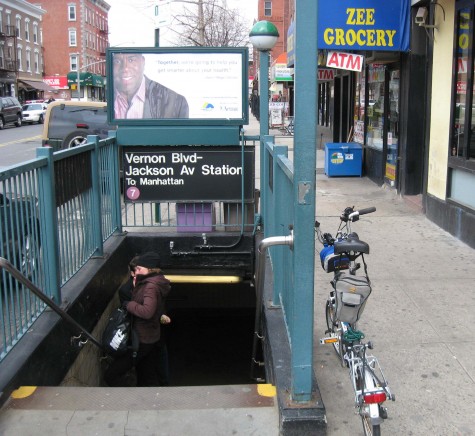
April 18, 2017 By Hannah Wulkan
A local group is celebrating the 100th anniversary of the first 7 train rolling in to Queens.
Transportation advocacy group Access Queens is throwing a 100th Anniversary celebration for the Corona extension of the 7 train, which saw the addition of 11 stations in Queens, from Queensboro Plaza to 103 Street-Corona. At the time, those stations were expected to take 15,000 commuters back and forth each day.
Today, the 7 train has 22 stations in Queens and services 525,000 riders each weekdays, with 622 trips across the line.
To commemorate the first trip from Grand Central Station in to Queens on April 21, 1917, Access Queens and the New York Transit Museum will hold a commemoration with several speakers, followed by a ride on the 7 train from Grand Central to Corona, on Friday afternoon.
The commemoration ceremony will kick off at 1 p.m. and there will be several speakers who will talk about the impact the train has had on the city and what’s needed in the future. The ceremony will take place on the Flushing-Bound Platform on the lower level at Grand Central.
The centennial ride will leave Grand Central around 2 p.m., which is the exact time that the first 7 train to go in to Queens left Grand Central 100 years ago.
“The 7 train is very important to Queens,” said Access Queens senior director Brandon Mosley. “When it shuts down, people and businesses in Queens are significantly affected. There are lots of memories tied to the 7 train, like the world fair, sports games at the Mets stadium or the tennis stadium, and access all the way to Flushing.”
In addition to commemorating the impact of the 7 train on Queens, the event will serve as a platform for transportation advocates to speak on the transportation needs in Queens and the improvements that still need to be made.
Mosley pointed out that the 7 train is currently undergoing a $774 million upgrade to add a computer-based control system, but he acknowledged that there are many problems that still need to be addressed.
“One thing that we want to do is take a step back and look at the big picture, because conversations about the 7 train have been happening on a granular scale and we want the conversation to be broader,” Mosley said, pointing out that often the conversation focuses on one specific aspect, rather than the system as a whole.
He said that one of the biggest concerns surrounding the 7 train is the expected influx of ridership on an already very busy train line. He pointed to the massive development in Long Island City adding “a new population the size of Albany,” and pointed to the anticipated L train shutdown bringing crowds of commuters in to Court Square.
“A hundred years ago when the extension opened, the city was anticipating 15,000 riders each day, but now there are 22 stations and more than 500,000 riders daily, so obviously ridership has increased beyond anything that original engineers would dream of,” Mosley said. “A lot of the components haven’t been updated for decades, and the MTA is playing catch-up now to upgrade the 7 train with computer based control.”
Other issues Mosley pointed out included the 7 train often skipping stations to stay on schedule and the lack of communication about delays and service changes well enough ahead of time.
Despite these issues, the 7 train is consistently ranked highly by straphanger reports. A report card from the NYPIRG Straphangers Campaign 1, 7 and L trains as the best in the city last year, pointing out that it has the highest amount of scheduled service in the city, is cleanest, and breaks down less often than the average line.
However, the report did note that the 7 line is very crowded and below-average in regularity of train arrivals.
Mosley said that the event on Friday would recognize the importance of the 7 train to the borough and to the city as a whole.
“Even though 7 train essentially has been around for 100 plus years, it’s our train and it belongs to us in Queens,” he said. “Queens matters, and is just as important as Brooklyn and Manhattan, so we deserve to have seat at table when discussing transportation. Though it has brought many headaches, most would agree that we want to preserve 7 train and make it better.”
A Facebook page for the event has been created for people to RSVP.

Survey photograph of site for 40th Street – Lowery Station, Queens: IRT Flushing Line], 8/18/1913;

Approach to Willets Pt Station (Transit Museum)
5 Comments

That’s all what officials and supposed concerned citizens do these days, have commemorations and events
The concept of celebrating a subway line that has decayed, is vastly overused and looks worse for wear today compared with when it opened seems misplaced. A protest would be more appropriate. I’ll wait to celebrate when the 7 line is a gleaming, modernized system suited for a 21st century metropolis.
FYI there are 18 stations in Queens, 22 on the whole line. A 100 year celebration is OK but let’s fix our mass transit and stop overdeveloping areas without proper PLANNING,such as LIC and making the trains seem more like CATTLE CARS.
you make it seem like it’s a simple process. Don’t complain. How would you “fix” mass transit? only so much space and resources that the city has. The MTA is a STATE authority. You want them to build brand new transit lines and at what cost? Then will you complain about the cost when someone has a new idea to “fix” the transit problems? Oh wait… you already do…. 😛
Will John L. Rocker give the keynote address?